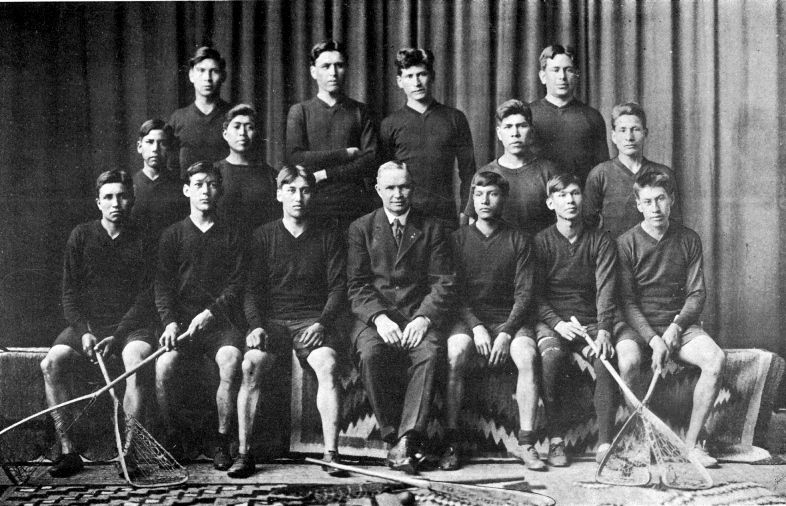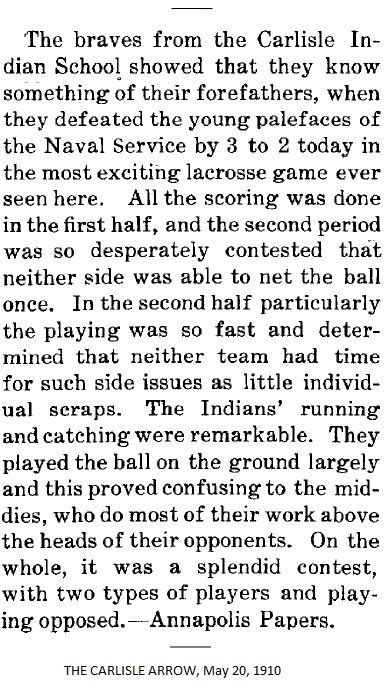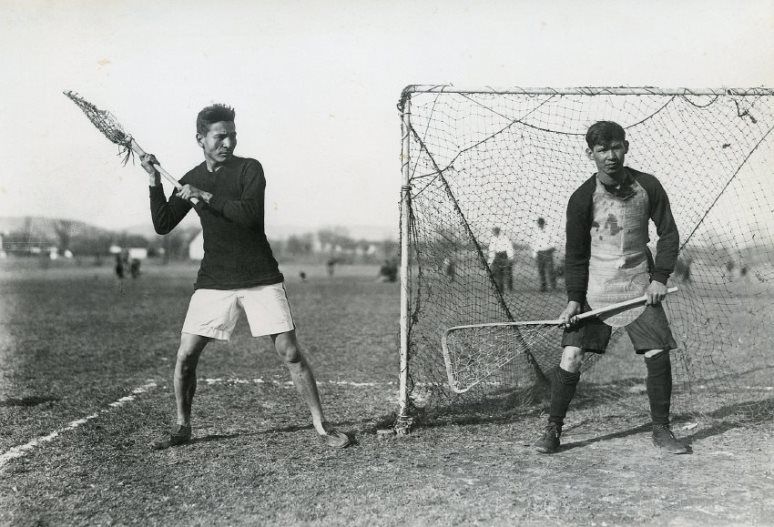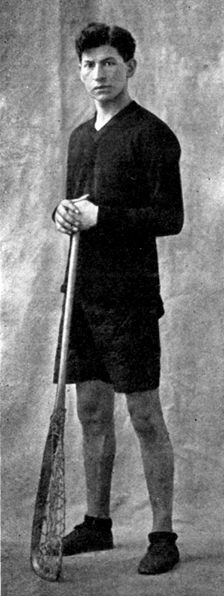In the late winter of January, 1910 Carlisle Indian School Athletic Director, Glen "Pop" Warner announced his intentions to replace the school's baseball program with lacrosse. His reasons for making the decision were twofold - to encourage summer work on farms and to keep male athletes from mingling with undesirable company. Indian school students could earn five times the amount of money playing baseball in summer leagues as opposed to earnings gleaned on farms as part of Carlisle's "Outing" system, thus making the lure of professional athletics more appealing than what school administrators considered the important, more beneficial skills available to young men working on farms or shops on "Outing."1 He laid the ills of professional athleticism at the feet of summer baseball programs, insinuating the Carlisle Indian School students lacked the fortitude to guard against consorting with "bad company" found on the baseball diamonds of summer leagues. This was also a foreshadowing of the issue of professionalism in sports by which Jim Thorpe, the famous Sac and Fox athlete was stripped of his Olympic Medals after it was learned he had played professional baseball in North Carolina. Since there were no professional lacrosse leagues during this era there was no conflict in that regard.2 Pop Warner believed that unscrupulous managers' only interest in hiring Indian athletes as professional players was because of their advertising value.3 Clearly, lacrosse would be a better alternative to baseball and Pop Warner began an ambitious lacrosse program at the Carlisle school.
The first practice was held the third week in January, with James Garlow (Tuscarora) acting as captain.4 Of the candidates reporting, the Iroquois students demonstrated the most experience "with the stick."5 By early February the school had recruited "the best lacrosse player in Canada," John White, to coach the newly formed team.6 Saturday, March 5, 1910 marked an historic event. Two Carlisle Indian School scrub teams played the first ever lacrosse game on the Athletic Field and few of the boys had ever played before. Coach White's task would be to cut the squad from 40 players to 30 by the end of the month.7 Among the many activities during the 1910 commencement week, lacrosse was included as an exhibition for the first time.8 The season schedule was announced, consisting of six consecutive games during April and May 1910. Carlisle's team would play Lehigh University, Stevens Institute of Hoboken, New Jersey; Swarthmore College; Baltimore City College, Mt. Washington A.C. and Navy. 9
Carlisle was defeated by Lehigh in their very first league game. THE CARLISLE ARROW characterized Lehigh as using "unusually rough tactics" which intimidated the inexperienced Carlisle team. The account of the game gave the first introduction to Carlisle's new coach, William T. O'Neil, who was expected to "make a good record before the season is over."10 The score was 3-2.
The team lost again the following week to Stevens Institute by a score of 6-4, and again the following week to Swarthmore with a score 5-3. The April 29, 1910 issue of THE CARLISE ARROW, reported:
The lacrosse team is doing very well for their first season, but some of the players could do a great deal better if they had more of the 'Do or die' spirit and did not give up so easily.11
Carlisle won the next game, which was played against Baltimore City College. In fact, it was a shut-out, the score being 15-0. Coach O'Neil was credited with the great improvement made by the lacrosse team and the expectation was expressed that the following week's game against the Mt. Washington Club of Baltimore would also be a victory for the Carlisle Indian School Lacrosse Team.12 Indeed, the forecast from the prior week proved to be true. The game was played in Baltimore with the Mt. Washington Club scoring their only point in the first half of play. Carlisle won scoring all their points in the last period, with a tally of 3-1.13
The final game of the 1910 proved to be a stunning victory for the Carlisle team. They defeated Navy in a "hard fought contest," 3 to 2. Credit was given to Captain Garlow and Coach O'Neil for the "spirit and hard practice" of the players.14
O'Neil was engaged to again coach the 1911 lacrosse team and for this season, Reuben Charles (Seneca) was elected captain only to be replaced two weeks later by Eddie Bracklin (Chippewa).15 Practices were announced along with the news that Harvard University was to be added to the schedule of games for the season.16 The competitions announced in mid-February included Baltimore City College, Lehigh, University of Maryland, Johns Hopkins, Harvard, Maryland Agricultural College, Swarthmore, Stevens Institute and the Mt. Washington Club. Three of the games were slated to be held at Carlisle's own Athletic Field - Baltimore City College, University of Maryland and Md. Agricultural College.17 Coach O'Neill arrived a week before the first game, which was scheduled to be played in Carlisle during commencement week.18 Although the team was plagued with bad weather during the first week of practice with their newly arrived coach, their first game against Baltimore City College ended in their favor with a score of 10-0. It was a fitting victory enjoyed by a large crowd of commencement visitors and Indian School students, who sat in attendance in the first half drizzle and second half pouring rain. Goals were scored by Reuben Sundown (Tonawanda Seneca), William Garlow (Tuscarora), Charles Clute (Tonawanda Seneca), James Crane (Umatilla), L. John and Joseph Jocks (Mohawk).19 Clearly, the Carlisle Indian School Lacrosse Team's hard work and diligence was beginning to pay off. The good feeling was short-lived, as the next game, with Johns Hopkins was hard fought, but a losing proposition. Carlisle lost by 3 points before leaving for Cambridge to play Harvard. 20 Meanwhile, Carlisle student Edison Mt. Pleasant (Tuscarora) published a traditional story of a fateful lacrosse game between the Mohawks and Tuscarora's that spoke to the powers of a Seneca medicine man. The article appeared on the front page of the May 5, 1911 THE CARLISLE ARROW in an obvious effort to drum up interest in the coming lacrosse contest against Harvard. The Harvard game was attended by "the largest ever at any lacrosse game played in New England" according to the May 5, 1911 issue of THE CARLISLE ARROW, and ended in defeat for the Indians with a respectable score of 2 to 1.21 The Maryland Agricultural College cancelled the next expected game and the following week, Carlisle handily trounced Swarthmore showing "fierce body checking and clever stickwork" according to the PHILADELPHIA RECORD.22 The 1911 team went on to beat Stevens Institute and the Mt. Washington Club in Baltimore finishing their season on a high note, before their coach, O'Neil, returned to his home in Cornwalis, Canada.23



